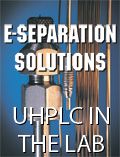UHPLC Technology Forum
New techniques in ultrahigh-pressure liquid chromatography (UPHLC) are providing scientists with additional ways to perform laboratory tasks.
New techniques in ultrahigh-pressure liquid chromatography (UPHLC) are providing scientists with additional ways to perform laboratory tasks. To learn more about the latest developments in UPHLC and the future of the technique, LCGC spoke with several experts in the field. Participants in this forum are Wulff Niedner, manager, LC products, Thermo Fisher; Mark Upton, liquid chromatography specialist, PerkinElmer, Seer Green, UK; and Doug McCabe, Senior Marketing Manager, Waters Corporation.
With the advances in column technology that have been occurring over the last two to five years, superficially porous particles (SPP) in particular, are the pressures of UHPLC required?
Niedner: While for sub-2-µm materials the very high pressures of UHPLC are required, ultrafast separations can be achieved with a similar or superior performance on SPP columns with 2.6-µm particle size at pressures between 400 and 600 bar. However for ultrahigh-resolution separations of complex mixtures or in method development using generic gradients, every plate counts. As the number of theoretical plates is proportional to the column length, an effective approach is the use of long columns with core–shell material, which again requires the typical UHPLC pressures.
Upton: The pressures of UHPLC systems are not necessarily required for SPP columns but there are some applications that require longer columns or higher flow rates where the pressures could exceed the 6000-psi limit of an analytical high performance liquid chromatography (HPLC) system. The real advantage of using a UHPLC system is the low system dead volume that allows you to fully realize the efficiency of the column. In our studies we have seen the efficiency nearly double just by optimizing an analytical HPLC system for low dead volume by replacing the capillary tubing, injection loop, and detector flow cell.
SPP columns can be run at flow rates above 6000 psi, affording exceptional throughput. For equivalent column efficiencies, SPPs generate less than half the back pressures of sub-2-µm porous packings.
SPP columns are limited in particle sizes, choices, and selectivity at this time, but columns packed with SPPs can incorporate coarser inlet and outlet filters and are therefore less prone to blocking and increased back pressure over time. The requirement to have the more extreme instrument pressure capability is much reduced, allowing UHPLC performance to be obtained on intermediate or existing conventional pressure pumping and injection systems.
McCabe: The logical next step in all particle development, whether fully porous or pellicular, is to go even smaller. This will require systems that can perform at higher pressures. When particle size is reduced to
The Complexity of Oligonucleotide Separations
January 9th 2025Peter Pellegrinelli, Applications Specialist at Advanced Materials Technology (AMT) explains the complexity of oligonucleotide separations due to the unique chemical properties of these molecules. Issues such as varying length, sequence complexity, and hydrophilic-hydrophobic characteristics make efficient separations difficult. Separation scientists are addressing these challenges by modifying mobile phase compositions, using varying ion-pairing reagents, and exploring alternative separation modes like HILIC and ion-exchange chromatography. Due to these complexities, AMT has introduced the HALO® OLIGO column, which offers high-resolution, fast separations through its innovative Fused-Core® technology and high pH stability. Alongside explaining the new column, Peter looks to the future of these separations and what is next to come.
Metabolomics Analysis of Low Birth-Weight Infants Using UHPLC-MS/MS Following Lipid Emulsion
January 10th 2025A recent study aimed to directly compare the changes in serum metabolites among very low birth-rate (VLBW) infants following the administration of the soybean oil-based lipid emulsion and soybean oil, medium-chain triglycerides, olive oil, and fish oil (SMOF) lipid emulsion using untargeted metabolomics techniques.
Analyzing New Drug Modalities: An ISC 2024 Interview with Kelly Zhang
January 10th 2025At ISC 2024 in Liverpool, United Kingdom, LCGC International interviewed Kelly Zhang of Genentech about her work analyzing new drug modalities, such as mRNA, oligonucleotides, peptides, and cell and gene therapies.
